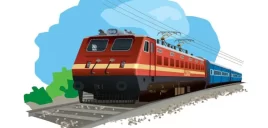Serial numbers: How are/were locomotives numbered in India?
Prior to 1940 or so, each railway company had its own system of numbering different classes of locomotives.
Beginning in the early 1940s, the state began taking over several of the railway companies, and newer locomotives acquired thereafter were allotted numbers based on the ‘IRS’ (and later ‘IGR’) classes; but numbers were duplicated across the different railways well into the 1950s. Some effort was made (especially by NR and WR) after 1952, when the zonal railways were set up, to avoid duplication of locomotive numbers across the zonal railways.
In 1957, new ‘all-India’ numbers were issued for most working locomotives in all the zonal railways to establish unique numbers throughout the country. The all-Indian numbers had blocks for each class of locomotive: e.g., numbers 22301 – 22500 were reserved for the BG XD class locos, and numbers 1000-1500 were reserved for MG diesel shunters. Some locos, such as the WCG-1 shunters, continued to be numbered with their old numbers together with the all-India numbers (e.g., 20038 (4513) where the number in parentheses might be, for instance, the old GIPR loco number). Over the years, the decline of steam and the growth in diesel and electric motive power has led to the reuse of numbers from blocks originally meant for steam locomotives for various diesel or electric locos.
A locomotive which has
undergone extensive repair work (perhaps following a collision) usually has an ‘R’ suffixed to the serial number. The ‘R’ suffix is also used for mid-life reconditioning overhauls such as those performed by DCW, Patiala or Golden Rock workshops. DCW, Patiala always used the ‘R’ suffix for overhauled WDM-2 locos (not upgraded to WDM-2C) before March 2000. Later, they used to renumber locos with the ‘R’ suffix even when they carried out the class upgrades to WDM-2C / WDM-3A (starting with 18690R). However, in recent years it’s been seen that as these upgraded locos are repainted by the various loco sheds where they are homed, sometimes the ‘R’ is omitted. E.g., Lucknow shed’s WDM-3A #18476, the oldest (1968) loco converted to a WDM-3A, no longer [2004] sports the ‘R’ suffix. Such locos (which had the ‘R’ in the serial number but later lost it) will always be in the shed-specific livery and not in the standard DCW livery.
If a loco, coach, or wagon is condemned (perhaps following severe damage in an accident), or not working well enough so that it is notionally written off, it may nevertheless be used after repairs in some limited circumstances; for example, condemned locos have been put to good use as shunting engines in yards. In such cases, a ‘0’ is prefixed to the serial number.
From about 1999, some sheds of IR (perhaps only on SR?) have begun the practice of adding a 2-digit year of manufacture in large stencilled numerals next to the road number for some electric locos, such as WAP-4’s or WAM-4’s. E.g., some SR WAP-4’s sport road numbers like 22219/97, 22536/02, 22626/05, etc. (the first two from Erode, the last from Arakkonam [7/06]).
Serial numbers were earlier painted or stencilled on in small numerals on the side of the loco cab; for locos up until the 1950s, usually the initials of the old railway company were painted on much larger. Since the late 1970s or early 1980s IR has been painting the serial numbers in large numerals on the sides of the loco bodies. Often the numerals are enclosed in a stylized oval or hexagonal frame that connects up to a stripe or stripes running along the length of the body.
This no longer applies to newly produced locomotives. New diesels do not have numbers painted on the long hoods. WAP-5s and WAP-7s do not have numbers painted on the sides. WAG-9s starting from the 3106x series again have standard sized numbers painted on the sides. Earlier WAG-9s had road numbers painted near cab doors under the yellow band in half the standard size. This was done away with for a few units starting 3104x and 3105x.
Serial number ranges for diesel and electric classes are in the loco specifications section.
Serial numbers are not always serial! Sometimes locos in the same class are assigned numbers out of sequence. The most recent example is that of the indigenous WAP-5 locos from CLW; the first was 30011, the second was 30013, and the third was 30012.
Hugh Hughes’ books are probably the best source of detailed numbering information for locomotives in India up till 1990.
Special-purpose units have various numbering schemes. E.g., EMU and DMU units sometimes have numbers such as ‘MC 0004’ where the MC stands ‘motor coach’. Accident relief vans are numbered, e.g., as ‘ARMV 5101’ etc. (ARMV = Accident Relief Medical Van). Cranes, diesel-electric tower cars for maintaining the
OHE, and other such vehicles are numbered separately. DMUs of various kinds have their own numbering system which resembles the road numbers of locomotives in consisting just of digits without any alphabetic prefixes or suffixes. The 1400hp HPDMUs have been seen numbered in the 14xxx and 15xxx range.
Public-sector locomotives
There are numerous locomotives (WDM-2, WDS-6, and other models) that are used by various public-sector units — power plants, steel or cement plants, collieries, mines, etc. for their internal freight-hauling and marshalling operations. These may have various additional markings or serial numbers, e.g. “BSP” followed by a number indicates a loco of the Bhilai Steel Plant; “NTPC” followed by numbers indicates a loco of the National Thermal Power Corporation. A loco belonging to the Rihand thermal power plant has been seen with the number ‘RhSTPP-II No. 04’. There is a rich variety here, which is unfortunately not very well documented anywhere, and is not treated by any of the more detailed works on Indian locomotives such as the books by Hughes, or Simon Darvill’s Indusrial Locomotive List. These industrial locomotives can often be seen on IR mainline routes as they travel to and from their maintenance and overhauling facilities which are usually at the bigger regional IR sheds.
Industrial locomotives
Please consult reference works such as Hughes’ books for detailed information on the numbering of locomotives used by private industry and public-sector industrial concerns. Hughes’ books have a lists of many locomotives sent to the public sector concerns and approximate serial number ranges or years of manufacturers for those manufactured by DLW or CLW.
Source – IFRCA.org
INFORMATION CENTER – www.informationcenter.co.in
This entry was posted in 2 Railway Employee, Locomotive, Railway General Information, Railway Employee











